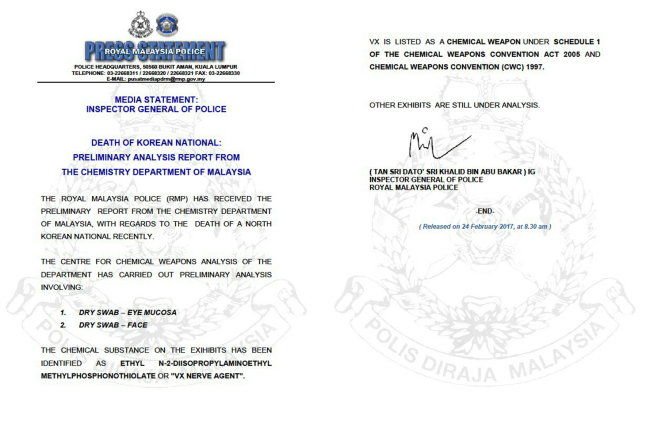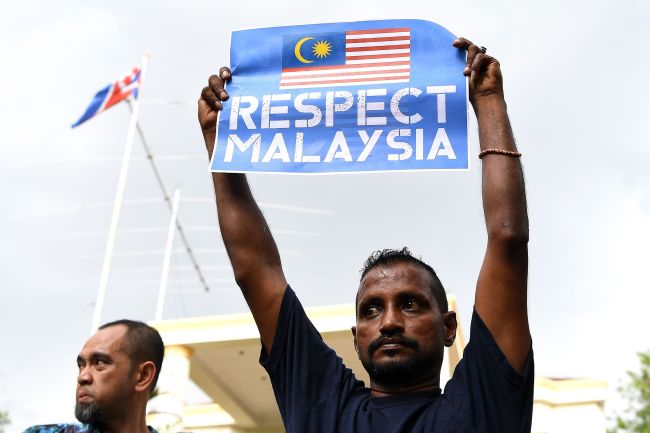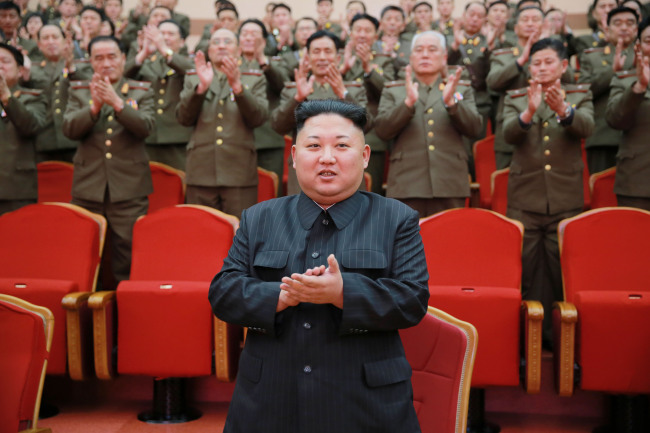North Korean leader Kim Jong-un’s estranged half brother was killed with a highly toxic chemical weapon known as VX, Malaysian police announced Friday, offering evidence that might unravel the mystery surrounding the death of Kim Jong-nam.
Citing preliminary analysis from the nation’s Chemistry Department, Malaysia’s police chief said the nerve agent was detected on the eyes and face of Kim Jong-nam, who died last week after being attacked by two women who approached him from behind and wiped his face with an unverified substance.
Deadly even in minute amounts, VX has been classified by the United Nations as a weapon of mass destruction. The substance is banned under the Chemical Weapons Conventions of 1997 and 2005, to which North Korea is not a party.The two attackers rubbed a liquid on Kim Jong Nam‘s face before walking away and quickly washing their hands, police had said earlier.
“Our preliminary finding of the chemical that caused the death of Kim Chol was VX nerve (agent),” Malaysia‘s Police Inspector General Khalid Abu Bakar said in a written statement, referring to the victim as “Kim Chol,” the name Kim Jong-nam is believed to have used when traveling on a diplomatic passport.

(Royal Malaysia Police)
The revelation that a banned chemical weapon was used in the high-profile murder case is expected to add speculation that North Korea might have orchestrated the attack after obtaining the substance themselves or from another country.
Hong Sae-yong, a prominent toxicologist in South Korea who works as a professor of nephrology at Soonchunhyang University Hospital in Seoul, said it is “not difficult” for North Korea to manufacture or export VX.
“A country with a certain science level can make the material,” said Hong in an interview with a local broadcaster, noting that even a religious cult -- such as Japan’s Aum Shinrikyo -- had manufactured 100 to 200 grams of VX gas that it used to attack innocent civilians in 1994 and 1995.
Last Thursday, Japanese broadcaster NHK quoted unidentified South Korean officials as saying that North Korea could have used VX to assassinate Kim Jong-nam and that the regime had done so in the past in similar operations.
VX is one of the most toxic and quickly acting chemical warfare agents, about 100 times deadlier than sarin, which has also been used as a chemical weapon, according to toxicologists. VX is believed to have been used by Iraq’s then leader Saddam Hussein on Kurds during the Iran-Iraq War of the 1980s.
South Korea’s Defense Ministry told lawmakers Monday that one of five toxic substances, such as VX gas, cyanide or hydrocyanic acid, could have been used in what he described as the “assassination” of Kim Jong-nam.

Members of the United Malays National Organization hold up a banner in front of the North Korean Embassy in Kuala Lumpur, criticizing North Korea’s handling of Kim Jong-nam’s death. (Yonhap)
Earlier in the day, Seoul’s Ministry of Unification urged Pyongyang to admit their responsibility for the attack and cooperate with Malaysia’s investigation into the case, which the ministry said has hurt the regime’s international reputation.
“It’s better for the North to admit (the attack) and cooperate with the investigation,” said Jeong Joon-hee, a ministry spokesman, at a regular press briefing. “North Korea should take into account that the more they act in this way, the worse their image will get.”
Since the death of Kim Jong-nam on Feb. 13, North Korea has lashed out at the Malaysian government’s investigation into the case, accusing the Southeast Asian country of having a “sinister purpose” to conspire with South Korea to sabotage the regime.
Pyongyang’s state-run KCNA news agency claimed Thursday that Malaysia had initially told them that the victim died of a supposed “heart stroke,” but changed its position after “false reports” surfaced in South Korea that he had been assassinated with poison.
So far, the Malaysian police have identified a total of eight North Koreans suspected of being linked to the killing. Having taken one into custody, they are searching for the other seven, although four are believed to have fled Kuala Lumpur shortly after the attack and are now believed to be in Pyongyang.
It would not be the first time the North used a toxic chemical to try to murder its defectors. In 2011, a North Korean agent was jailed in South Korea for a plan to use a poison-tipped needle to assassinate Park Sang-hak, a human rights activist from North Korea who defected to the South in 1999.
North Korea is estimated to have a chemical weapons production capability of up to 4,500 metric tons for a typical year and 12,000 tons for a period of crisis. The weapons reportedly include mustard gas, phosgene and sarin gas, a United States Congressional Research Service report said last year.
By Yeo Jun-suk (
jasonyeo@heraldcorp.com)

(Yonhap)
By Yeo Jun-suk (
jasonyeo@heraldcorp.com)






![[From the Scene] Monks, Buddhists hail return of remains of Buddhas](http://res.heraldm.com/phpwas/restmb_idxmake.php?idx=645&simg=/content/image/2024/04/19/20240419050617_0.jpg&u=20240419175937)

